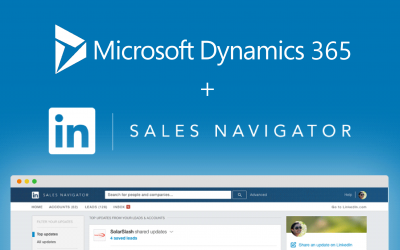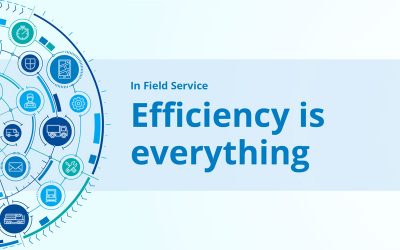No Results Found
The page you requested could not be found. Try refining your search, or use the navigation above to locate the post.

The mantra’s stuck around for a reason, but the route to the promised land has changed.
Now, surprise and delight means not only delivering great customer experiences, but leveraging the power of tech in doing so – a fact that holds true for field service organisations in particular.
The reality is that in today’s hyper-competitive, tech-saturated marketplace, customers have come expect more than ever before from Field Service Organisations (FSOs):
At the same time, strategies that place too much value on new customer acquisitions through a short-term tech focus tend to be unsustainable.
So, how can FSOs navigate this new business landscape and use tech to power long-term sustainable goals? Here are five rules to bear in mind:
The next client … the next big sale … focusing too hard on these can come at the cost of your current customer base.
Remember: your existing customer base is your most profitable base. Also: it’s expensive to acquire new customers. Your current customers’ experience with your organisation should therefore be a high priority. So, improve the customer journey, making sure it’s studded with positive interactions and value-adds – repeat business and referrals await.
Consider this: a customer calls in, needing to have a piece of equipment repaired. The repairs are done, and the customer walks away happy. However, since the customer isn’t a specialist, what he’ll remember most about the process is the customer service he received. Sometimes it’s just as much about how you make a customer feel as the actual service you provide.
However, the reality is: your competitors get it. They know the value of tech. And chances are, they’re investing in it a big way.
The result? When enough businesses begin to transform, everything in the marketplace changes. The benchmarks customers expect service providers to meet go way up. The ways in which clients expect to interact with businesses (including yours) are completely remade.
Consider:
The right data analysis can reveal everything from up-sell and cross-sell opportunities, to ways in which to maximise your most profitable customer relationships, refine service delivery based on past feedback and identify your most profitable customer groups and product types. Gone is guesswork. In its place – data-guided decision making.
More importantly – data is the core of personalisation. And personalisation has come to define the most critical interactions in business today. Customers expect you to understand their needs and provide tailored, individualised service. To do that – and do it well, without draining your resources – you need the right tools to dig into your data.
For example, by knowing what products or services a customer ordered from you in the past allows you to streamline how you interact. It also allows you to suggest relevant options, upgrades and associated services.
Schedule optimisation is one internal process that can drastically improve profit. For example: by using Microsoft Dynamics 365, technicians can dramatically increase the number of appointments they’re able to fit in each day, improving both productivity and profitability.
As your business grows, increasing efficiency becomes paramount. Failing to put the systems in place to allow you to grow – without adding to headcount – can mean the difference between linear and exponential profit growth.
Field techs are the face of a business. So, make sure you empower them to consult with and add value to each client interaction.
This can mean anything from adding a touch of personalisation to every meeting, going the extra mile when it comes to fulfilling an order, or using tech to streamline order processing, parts ordering and payment. Doing so can be a powerful differentiator in the market.
The page you requested could not be found. Try refining your search, or use the navigation above to locate the post.
Discover More Stories

Get an hour back each day. That was the conclusion of global tech analyst, Nucleus Research when they looked at LinkedIn’s Sales Navigator with Dynamics 365 for Sales. Putting it another way, using this combination gives you a 12-15% increase in your productivity. Think how many more deals you could close because of this.
This is a big claim. But it’s not unreasonable. We’ve been using LinkedIn Sales Navigator with Dynamics 365 for months, and have been experiencing the benefits.
Now, when a lead comes to us we get all the data from LinkedIn alongside it. From this one lead, we can easily identify all the stakeholders associated with the deal – without leaving Dynamics 365. We can see their photos, job title, past work history, connections, etc. It’s incredible.
But don’t just take our word for it, you can read the report here. Or better still, see it in action in this short video:
Nucleus Research concludes:
“Clearly Microsoft has an advantage with the sheer volume and granularity of business relationship data within LinkedIn.”
What’s stopping you from having that advantage too?
Talk to us today.
The page you requested could not be found. Try refining your search, or use the navigation above to locate the post.
Discover More Stories

Gartner went on to state:
The page you requested could not be found. Try refining your search, or use the navigation above to locate the post.
Discover More Stories

The companies that get it right reap the rewards. Consider the stats:
To keep customers engaged, however, companies must compete in a marketplace where the benchmarks keep rising. Why? Exposed to the offerings of best-in-class digital juggernauts such as Amazon, consumers develop a taste for the most cutting-edge tech – and soon come to think of it as normal – whether they’re aware of it or not.
What are the drivers? A major one is advancement in AI. Today, artificial intelligence underlies an increasing number of customer service interactions – at both the front and back end. From brand spokesperson to service agent assistant, AI is remaking the interface between brands and their customers.
ow? Here are some of the ways.
AI is many customers’ first touchpoint.
Many of today’s consumers would rather find a solution to a query without having to dial into a call centre or deal with a service agent over the phone. Brands know this, and it’s why chatbots are an increasing number of brands’ first line of contact.
Easily accessible via a messenger window, bots are great at dealing with simple and medium-complexity queries. The result is quick customer resolution as well as decreased workload for the company’s human agents – to whom a bot might refer a customer in the case of a complex query.
By filtering incoming queries in this way, companies are realising that a human touch isn’t always necessary. Rather, it’s efficiency that customers want.
AI – which is able to draw on a range of data spanning past brand interactions (and often external data, too) – isn’t working from a blank slate. Rather, it’s able to contextualise queries, making sure replies are targeted, helpful and to the point.
AI is flexible.
Today’s customers take digital dynamism for granted. Daily immersion in tech means multi-device connectivity – and interaction on their own terms. For many, their nearest bank branch is an app. Their nearest retail outlet, their mobile. Brands have to keep pace. Access to a device means access to AI, whether via a messaging app or website.
AI is predictive.
Consumer queries are rarely totally unique. An issue or question raised by one customer is likely to soon be voiced by another. AI comes into its own in this area.
On one hand, when the same query is raised by a number of consumers, AI begins to learn. By piecing together the reasons behind a specific type of query, AI can learn to provide more helpful and targeted solutions to subsequent customers – having found what resolution worked best for those who came before.
More importantly, AI is able to predict queries before they happen. Through IoT-enabled devices, weather forecasts, inventory management services and more, AI can now anticipate when a customer is likely to call in, and why.
The result is the ability to pre-empt queries and surprise customers with helpful suggestions, at just the right time.
Building Business Dynamism
Microsoft Dynamics 365 offers an embedded suite of advanced AI capabilities, capable of tackling complex scenarios end to end. Here are four ways:
Want to find out how you can infuse AI into your customer service?
See our AI-enabled customer service solution.
1 Shifting the Loyalty Curve: Mitigating Disloyalty by Reducing Customer Effort by the Corporate Executive Board (CEB)
2 2016 State of Global Customer Service Report, Microsoft
The page you requested could not be found. Try refining your search, or use the navigation above to locate the post.
Discover More Stories

Conclusion: customers love efficiency. They stay loyal to companies able to offer it. However, very few businesses are able to offer the kind of service that keeps customers coming back. If you’re one of the few that can, you’ve got a powerful market differentiator – one that can allow you to carve out a niche in the market.
Here are 4 ways the right toolset can drive efficiency for that market-leading edge.
1. Intelligent Scheduling.
A great top-down view is key to optimising service delivery. If dispatchers can access real-time information on where technicians are, accurate, efficient scheduling becomes possible. Workloads and resources can be better balanced too, and more appointments scheduled per day. The result: productivity gets a massive boost.
On-site assistance should be carried out only when necessary. The right technology can help you detect, troubleshoot and resolve issues remotely when possible. Remote monitoring and predictive maintenance also become possible when you have the right tools. Moreover, systems can be designed to ask customers the right questions upfront. Do this and you can ensure you dispatch technician only when necessary – and that when you do, you always send the right person for the job.
Admin is the enemy. It eats into energy and resources. By streamlining the back office, your time is far better spent. The right technology means that client emails, phone calls and appointments can be monitored at the click of a button, and stored in one place, against their client record. Clients can also be kept informed at any stage of the engagement, with updates being sent by staff from any device. Further, when you have the ability to generate reports instantly, you can prioritise the most important clients and ensure you always provide great experiences to your customers.
Field service organisations have tons of info to keep track of. And while background information is key, it can quickly become a burden. Technology can provide key alerts and prompts, making insights actionable. For example, when service contracts, warranties and installed products are kept up to date, business flows far more smoothly. Driving additional revenue becomes possible too. Accurate contract information can ensure you are offering renewals at the right time, and not letting any contracts expire.
Get in touch.
The page you requested could not be found. Try refining your search, or use the navigation above to locate the post.
Discover More Stories